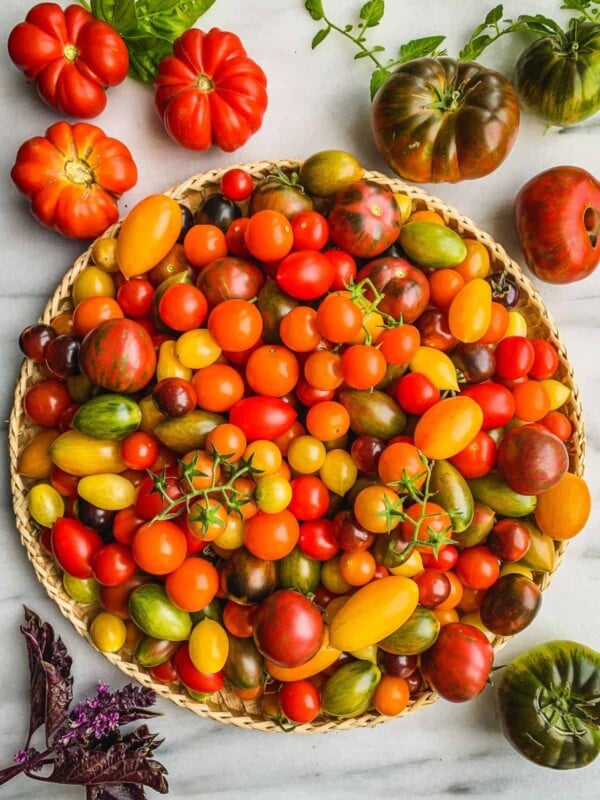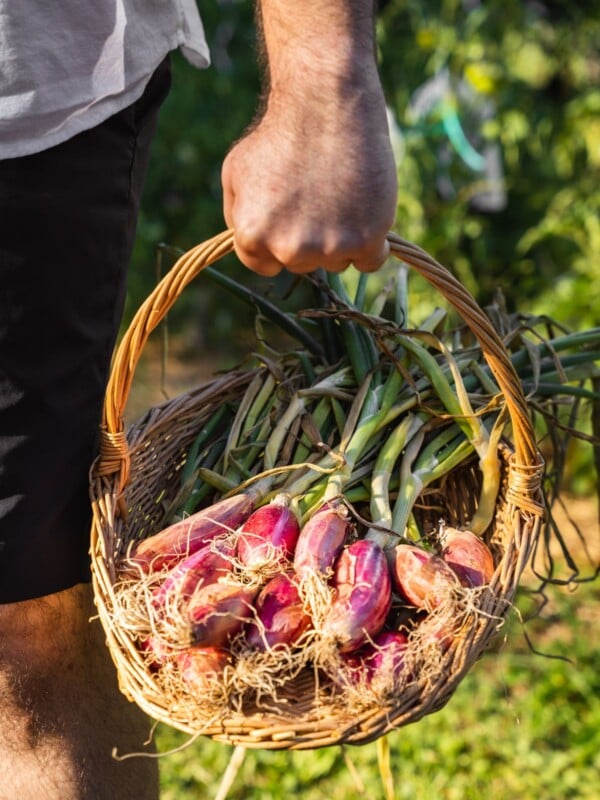Chimichurri, compound butter and freezing are just a few ways to preserve parsley for future use.

Table of Contents
One of my must-grow herbs, parsley is a staple ingredient in my kitchen. It can be used to dress up grilled asparagus, garnish homemade hummus, or top a tomato puff pastry tart. Use it to make Tabbouleh (Middle Eastern Parsley Salad). The great thing about growing your own herbs is that you can use as much or as little as you need for a given recipe.
Make sure to check out my complete Parsley growing and cooking guide.
If you live in a cool climate like me, you’ll probably want to harvest it all before winter kicks in. I typically harvest an obscene amount of parsley at the end of the season. It takes over an entire shelf in the fridge. I have to think fast and process it for future use as there is no possible way to get through it all.
Even if you do not grow you own, parsley bunches from the grocery store can be quite large and getting through them before they turn to mush can be challenging. Preservation is key to reducing food waste.
Freezing Parsley Leaves
Although parsley can be frozen, it will definitely lose its vibrant texture when it’s defrosted. Frozen parsley will work in any recipe that calls for this herb to be added towards the end of the cooking process, like in stews, pasta sauces or curries. It will not be appropriate for salads or other fresh preparations.

To preserve, wash and dry thoroughly. You want to make sure no excess water is present as that can cause freezer burn. Cut the lower part of the stems (don’t discard, see below). Place cleaned and dried parsley in a large freezer bag and push it down to the bottom. You want to create a compact log or cigar.
Roll the log and squeeze out as much air out of the bag as you can. Seal and freeze. When you need some parsley, simply pull out the log and cut what you need, seal the bag back up and return to the freezer.
Freezing Parsley Stems
Parsley stems are full of flavor but they can be tough and unappetizing. Although you may not want to eat them fresh, they are perfect in broth. They add a subtle herbal flavor to vegetable or chicken broths.
What I like to do is loosely pack them in a freezer bag, squeeze out as much air as possible, and seal them. When it’s freezing outside and the weather calls for a soothing and comforting soup, I will have parsley stems ready to add vibrant flavor. When needed, simply crack off a chunk of stems and return the bag to the freezer.
Parsley stems can also be pulsed with carrots, celery and onions when making Bolognese or other meat based sauce that call for mirepoix (like my Short Rib Ragu or my Beer Braised Short Ribs). They can also be added to chili, stews and other dishes that require a long cooking time, allowing the stems to soften and break down.
Parsley Compound Butter
Another great way to preserve parsley is by chopping it up finely and mixing it in with softened butter. This flavored butter can be added to sauces, used to garnish cooked steak, or added to pan-fried fish. The possibilities are endless.

To make your compound butter, chop the parsley finely and combine it with softened room-temperature butter. Once mixed, place the butter on a sheet of saran wrap. Use the saran wrap to create a butter cylinder and twist the sides (like a candy wrapper) to create a tight log.
Freeze the log for 15 minutes, then slice the butter log into coins. Freeze coins solid in a container or freezer bag and you’re good to go! Fresh homegrown parsley in the middle of winter.
For more compound butter ideas, check out my book, Seed to Table, which features a section on preserving homegrown produce.
Herb Cubes
Another great way to preserve parsley (or tender herb) is to freeze it in oil. The frozen cubes of parsley oil can then be used to flavor roasted vegetables, used to make a quick finishing sauce or salad dressing.

In a food processor, pulse the cleaned dry parsley until it’s roughly chopped up. Don’t over-process or you’ll end up bruising the leaves. Transfer the chopped parsley to an ice cube tray. Pack the parsley in, this way you’re not wasting space.
Carefully and slowly pour your oil of choice (I recommend olive oil) until all the leaves are submerged. Transfer the tray to the freezer. Once completely frozen, transfer the herb cubes to a freezer bag. Use within 12 months.
If your freezer is not cold enough, the cubes may not hold their shape. Make sure your freezer is set to the right temperature.
Chimichurri
This classic Argentinian condiment is so easy to make, I guarantee it’ll be in your repertoire for years to come. Traditionally eaten with grilled meats, it can be enjoyed with fish, chicken, or grilled vegetables.

At its core, chimichurri is made with fresh parsley, oregano, garlic, olive oil, and red wine vinegar. Some folks will add cilantro (like in my Cilantro Chimichurri), others will add chili flakes. The great thing about chimichurri is that it’s adaptable.
Get the recipe for my Authentic Chimichurri here as well as the Cilantro Chimichurri version.
If you have any parsley preservation ideas, let me know below! For more Urban Farm and Kitchen, follow along on Instagram, Facebook, and Pinterest, visit the Urban Farm Shop, or subscribe for new posts via email.












Thank you!! I just picked parsley from my garden this will be wonderful for my Thanksgiving day dressing.
Glad to hear that! Enjoy!
Thank you! This was really helpful, as I have just returned with 3 full bunches of parsley!!!